Guess what! It`s Saturday - and that means it`s newsletter time all over again. And since last week I have discovered a much better way of not only doing lists but keeping them in columns. That will slowly roll out back into the earlier newsletters as well.
This week, whilst sheltering from the heat, and waiting for nipper to come out of the clippers (though I did have a coffee at Waitrose as well during those couple of hours), I did get quite a lot done. And I also did the longer descriptions first. I also had help with the theme of the week from a reader. So all in all a lot got done and the newsletter is pretty much ready to roll long before I hit my sleeping bag.
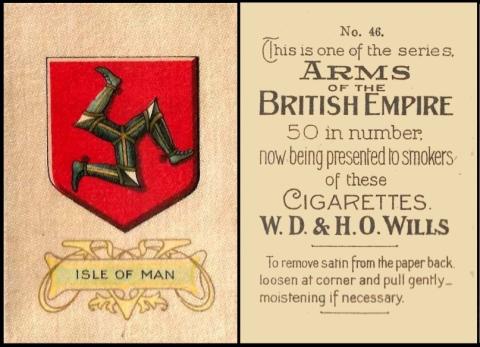
W.D. & H.O. WILLS [tobacco : UK - Bristol] "Arms of the British Empire" (1910) 46/50 - W675-391 : W62-55 : X21/200-126.2 : RB.21/200-126.2 : W/126.A :
Is there anyone reading this in the Isle of Man? If so you most probably know that today is Laa Tinvaal - the National Day of the Isle of Man - or, in its English translation, Tynwald Day, though you may know it better by its more natural name of the Midsummer Court ? Which actually tells another tale, for originally it was held on Midsummer Day, the 24th of June ; and you can blame the changing of the calendar in 1753 for this new date.
Now I must admit that I erred a bit by choosing this, as though this is, for the most part, an annual event, every 5th of July, sometimes the date falls at the weekend, as it does this year, and in that case the ceremonies are moved on to the Monday.
One of the most important events of those ceremonies is that for one day only, ever since the tenth century, the Tynwald, which is the governing body of the Isle of Man, decamps from Douglas and winds its way up to St John`s in Glenfaba. The session then takes place partially in the Royal Chapel of St. John the Baptist, and the other part in the open air, on a small hummock which is known as Tynwald Hill. And at this point we must also give another nod to history, for the original date, of the 24th of June, was actually St. John the Baptist`s Day.
As far as the three legged emblem, this is the Manx Coat of Arms, and it is proudly displayed in that Royal Chapel of St. John the Baptist, next to Tynwald Hill. Which is why it is actually a last minute replacement for the card I had before - on saying which I am really delighted to be able to use this card because a long time ago I used what I wrote up as a Wills set, only to be corrected that the picture showed the version of the set which was issued anonymously. So here we do have a card of the Wills version, and it means that I can go back and add in the details of the anonymous version as well.
This set, with the anonymous version, first appears in the fourth part of our original Wills reference books, that being RB.16 – The Cigarette Card Issues of W.D. & H.O. Wills Parts I, II, and III (revised) and Part IV. This book was not published until 1950, which seems a very long wait to record a set issued in 1910, until you find out that this version of the set was printed not in England, but in Australia. More curious still is that the card version of this set, issued as two sets of fifty, were not circulated until November 1931(for the first series) and April 1932 (for the second series).
The medium sized silk version, which we show today, is catalogued in that book as :
- 126. 50. ARMS OF THE BRITISH EMPIRE. Fronts printed on satin in colour. Backs on thin board, with instructions for removing satin. Many of the subjects are based on similar originals to those used in Item 40 (see page 90). Australian issues, between 1910-1915 -
A. Medium cards, size 70 x 48 m/m. Backs in black, inscribed "W.D. & H.O. Wills." Numbered on backs
We know that there is also a large sized set, one version of which appears in our newsletter for the 3rd of August, 2024 - just scroll down to Tuesday August the 6th. At the moment that has no write up in the way of data from the reference books, but it will, asap. I have only had time so far to do the standard and medium sizes. That set is anonymous, and does not mention Wills. The numbering differs in the two sets, and although they are said to be similar, they have not been compared card for card so there may be differences.
Now before we rocket on, let us return to "Item 40", which is the standard sized set, also entitled "Arms of the British Empire". We used that as the Card of the Day for the 19th of December 2021, which is the home page for the entire group. Or it will be asap....
Our version next appears in our original British American Tobacco Company Booklet, RB.21, published in 1952, where it is RB21/200-126. The text there reads :
200-126. ARMS OF THE BRITISH EMPIRE - Silk-Fronted.
The recording in W/126 requires to be amended as follows :-
- A. Wills Overseas issue. Size 70 x 48 m/m. Back in black
In our original World Tobacco Issues Index, the set is listed under Wills section 3.B, devoted to "paper backed silks. Issued 1911-17. When detached from their backings, all silks are anonymous." The entry for our set reads :
- ARMS OF THE BRITISH EMPIRE. Md. 70 x 48. Nd. (50). See X21/200-126.2 ... W62-55.
This is more or less the same in the updated version, but the X21 code has been replaced by RB.21/200-126.2, and the card code by W675-391.
The "X" code is actually for the handbook to the original volume, and the entry in there reads as follows :
- ARMS OF THE BRITISH EMPIRE. The recordings under W/40 and RB.21/200-126 are summarised and amended below.
Set 2. Medium paper-backed silks, 70 x 48 m/m. Front per No.2 at Fig.X21/200-126. Wills Australian issue. Numbered series of 50, different numbering from Set 1 [the small sized cards]. The subjects are similar to those in Set 1 in 43 cases, but the designs are mostly altered and all redrawn. Nos. 20, 34, 43, 44, 45, 48 and 50 differ entirely from any in Set 1.
To save you hunting, here is a list of those seven numbers, along with a comparison to the arms which appear on the cards - which was entirely supplied by my Wills Specialist, because I failed to find a satin version of any of these numbers online. Six of these are indeed different, but number 45 is Sierra Leone in both the satin and the card version, so it is possible that this was either a typing error in the original listing, or more likely, that lists of numbers were supplied by more than one collector and amalgamated, but the hand writing was hard to decipher and on one list a 43 or a 48 was mistaken for a 45.
| No. | Standard card | Medium Satin |
| 20. | Natal - | The State Badge of South Australia |
| 34. | Alberta - | England |
| 43. | Madras - | Union of South Africa |
| 44. | Gibraltar - | Tasmania |
| 45. | Sierra Leone - | Sierra Leone |
| 48. | Canada - | New Zealand |
| 50. | South Australia - | The Bermudas |
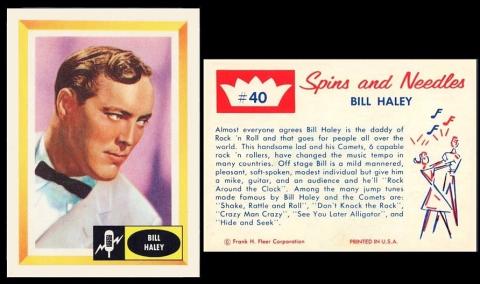
FLEER Corporation [trade : bubble gum : O/S - USA] "Spins and Needles" (1960) 40/80 -
William John Clifton Haley was born in Michigan, today, in 1925, so today would have been his hundredth birthday - and many more people now are indeed alive to celebrate such a thing.
Little is known of his childhood. We do know that when he was four years old he lost the sight in his left eye, during an operation on his ear, when a nerve was accidentally cut. And that when he was seven his family was badly affected by the Great Depression and moved to Pennsylvania, hoping things would be better there.
Music ran in his blood. His father, a Kentuckian, may not have had much schooling but he could play almost any instrument, though he liked the banjo best. His mother was actually a Lancashire lass, and she had been classically trained on the piano. I cannot find out how, with such differing backgrounds, these two even met, but it seems to have been in their stars.
Like most budding musicians, Bill Haley soon started entertaining the locals, and joining bands. He reportedly left home at fifteen to make a name for himself, feeling that his talents were destined to find themselves a fame. It was not as easy as that, but travelling taught him a lot and he heard music he would never have otherwise come across. Many bands of the time can claim that he gigged, or even did a proper stage set with them; and he even picked up odd work at fairgrounds when he could. Maybe because of this environment, he seems to have specialised in Country and Western; his first real band of his own were known as "The Four Aces of Western Swing", later known as "Bill Haley and his Saddlemen". In addition he taught himself to yodel, and is regarded by many to have been the best western yodeller of all time.
During this time, he became involved with a radio station WPWA in Pennsylvania, for whom he was their musical director. I am not sure if by this time he had stopped touring, but it seems to be about the time he was divorced from his first wife, after six years of marriage and two children.
Four days after the divorce he remarried. This lady gave him five children, but it too ended in divorce in 1960.
By the way, it was the same radio station who, in 1952, had given him and his band another name, of "Bill Haley and the Haley`s Comets". They made several records, and had some success, then, in 1954, they recorded another song, a catchy tune called "Rock Around the Clock". It did make the American charts, just inside the top forty, for a couple of weeks. Their next song, a cover of "Shake, Rattle and Roll" did much better, and was actually the first million-selling rock and roll record, even reaching the lower end of the charts right across in the UK.
Perhaps it was because of this that he had a huge stroke of luck, for suddenly his earlier song, "Rock Around the Clock" was selected to appear in a motion picture, this being "Blackboard Jungle", starring Glenn Ford and pretty much introducing Sidney Poitier to stardom. Its school setting, and its rebelliousness led to it being one of the must see films for teenagers, though they were not the target audience - but that also brought the song back to their ears, and it became a huge hit, even being re-released as a single, which was number one of the American charts for a massive six weeks. It even re-entered the UK charts making number one on and off right through to the Autumn of 1956 - and it was the first million selling single in the United Kingdom.
Despite all this, Bill Haley seems to have sunk into a deep depression. He envied the success of his contemporaries and younger stars, but, as a private person, generally chose to shun the limelight, and turn down personal appearances. And so his fans seem to have started to move on to musicians, often younger ones, who were more of a presence in the teen magazines which were becoming so popular.
What seems to have changed this was this third marriage, in 1963. He even started to tour in the late 1960s, and even came to England for the Royal Variety Performance in 1979. He planned to tour Europe the next year, but it never worked out. Then, on February 9, 1981, aged just fifty-five, he was found dead in his bed, after what is thought to have been a heart attack. His third wife seems to still be alive.
Today his fame lives on, encouraged by his son by his second wife not only runs a tribute band, Bill Haley Jr. and the Comets, but has written his father`s autobiography.
As far as his card autobiography, most of the early paperboard portrayals came on European or "Dutch" Gum. One of these, which you can find with a plain back or with a printed back, advertising Hellas` "Jenkki" chewing gum, is very interesting, because it is often quoted to have come from a film - however it was a snapshot, taken on October 23rd, 1958, when Bill Haley was touring Europe, and Elvis Presley, then on National Service, attended a show and went backstage. This is not apparent from the card though, as they have changed the colour of Elvis`s clothes into a red coat and hat, instead of showing him in uniform.
Ours is a set which few people have heard of, and yet it is such an excellent snapshot of the 1960s, starting with Della Reese as card 1, then including other luminaries of the music industry like Paul Anka, Pat Boone, Andy Williams, The Drifters, Jerry Lee Lewis, Les Paul and Mary Ford, Carl Perkins, Duane Eddy, The Impalas, and the Shirelles. The problem seems to be the title, which, if seen in an auction list, or sales catalogue, does not immediately suggest music - it is clever, but perhaps too much so. The packets cost five cents each and contained the cards, plus bubble gum. Printed on the packet was an offer to send off two packets and 25 cents and you would get an actual 45 r.p.m. record.
The last card of him to be issued in the 1960s is part of Bergmann`s "Schlager Star Parade", circulated during 1969. It shows him wearing a blue coat and playing his guitar.
The only other card of him known until the mid 1980s is Italian, part of "L`Album per le Figurine della Televisione", issued in Italy, in 1979 by Sorrisi e Canzoni. The set is said to be complete in 411 stickers, but they are not stickers, at least not self adhesive, so some form of attaching them to the page had to be found and this led to many cards suffering with either sellotape yellowing, or from the effects of using too much glue. In addition the subjects were all art drawn, and by almost the 1980s that gave them rather an old fashioned feel when compared to the photographic cards of stars that were so readily available.
It was only when more musical subjects started to feature on commercial cards that he re-appeared.
Strangely, one of his first modern cards teams him once more with Elvis. This was published by The River Group and uses a photo taken on August 20th, 1955.
As for his first appearance on a Topps set, that comes in 2011, as part of "American Pie" - available in three formats, a base card, a foil card, and a "spotlight" card. Unfortunately they use a black and white image, when there are so many coloured ones.
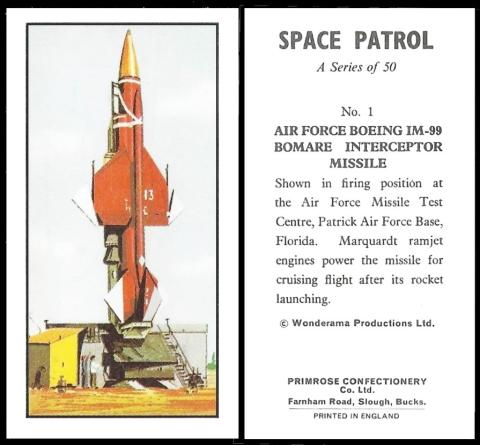
PRIMROSE Confectionery Co. Ltd. [trade : confectionery - sweet cigarettes : UK - Slough, Berkshire] "Space Patrol" (1965) 1/50 - PRI-320.C.a : PRI-16.C
Now for our second centenary card, which is rather a tangent. What we are celebrating is the first successful passenger aircraft, the Boeing Model 40, which flew, on this day, in 1925, though actually it was designed as a mail plane, to carry the post across America.
The word "successful" is the important one, for there had been passenger flights, even as far back as November 21, 1783, when the Montgolfier brothers took two men, Jean-François Pilâtre de Rozier and the Marquis Francois d'Arlandes, as passengers, in their hot air balloon. And in May 1908 their mechanic was a passenger in Wilbur Wright`s biplane at Kitty Hawk, North Carolina. There had also been airlines, most notably one which used a flying boat to transport passengers between St. Petersburg and Tampa, Florida; that began in 1913, but stopped in 1914.
It was a piece of legislation called the Air Mail Act that changed this by lifting the post office monopoly on the delivery of airmail and allowing private companies to tender for the various routes. There was another reason too, as the mail was being flown in aircraft that had been inherited from the forces, Airco DH.4s, and yes, the DH was indeed De Havilland. They had large engines, which could cope with mail runs, and best of all they were stable and easy to fly; however in the mid 1920s they were showing their age, though Boeing, which was founded in 1916, had already been involved in keeping them flying.
So Boeing, who first tested their aeroplane today, July 7th, in 1925. kind of thought they were a shoo-in for winning, only to find that Douglas won the contract.
That was not the end of the line for Boeing, as pretty soon after, the Post Office sent out another tender, to deliver the mail between San Francisco and New York. As this was a long flight, almost two thousand six hundred miles, they split it into two, one ending and one beginning at Chicago. And Boeing won the San Francisco to Chicago route, mainly by pitching the lowest bid they possibly could, helped by the fact that they only had to modify the aircraft they had built for the first tender. This new version was the Boeing Model 40.A, which had a steel frame and aluminium and wood across the fuselage, plus a lighter engine.
Now I tried to find a card of that, but failed. Maybe there is one out there somewhere.
Instead I went for the card above, which mentions Boeing in conjunction with space travel, which most people still believe will be the next big thing in passenger travel. It`s not as big a jump as you may think though, because Boeing built the first stage of the Saturn V rockets in the late 1960s, the Lunar Rovers, and part of the ISS - and right now they are involved with the Starliner, which, in their words, "...will take people to and from low-Earth orbit".
At this point we must note that "Space Patrol" was a British sci-fi tv series, by Wonderama Productions, similar to the series by Gerry Anderson, and also using marionettes. It first screened in 1963, but was set in the year 2100, by which time the peoples of Earth, Mars and Venus have joined together in harmony to set up the United Galactic Organization. Though despite the harmony, the Space Patrol was the military force, led by Captain Larry Dart, who was voiced by Dick Vosburgh, a man of many talents. And the series is also notable because it was written by Roberta Leigh, the first woman producer in Britain to have her own film company.
However, this set is very much more than a television tie in as it shows actual space technology. Our card shows the first missile to be developed by Boeing, during the Cold War, and, in truth, the first long-range surface-to-air anti-aircraft missile of them all.
The set first appears in our original British Trade Index, published in 1969, as :
- SPACE PATROL. Sm. 65 x 33. Nd. (50). ... PRI-16
A. Back "Send only 9d. .." address (a) with (b) without "Argyle Ave"
B. Back "Send only 1/-..." address without "Argyle Ave"
C. Back "Send only 1/-..." address "Farnham Road". "Printed in England" at base.
Now by the time of our updated British Trade Index, published in the year 2000, there has been an addition, regarding our part of the set, so the entry now reads :
- SPACE PATROL. 1965. Sm. 64 x 33. Nd. (50). Backs: ... PRI-320
A. "Send only 9d. .." address (a) with (b) without "Argyle Ave"
B. Back "Send only 1/-..." without "Argyle Ave"address
C. Back "Send only 1/-..." address "Farnham Road". "Printed in England" at base. Found (a) with (b) without "Wonderama Productions Ltd." above album clause.

SANITARIUM Health Food Company [trade : cereals : O/S - Australia] "Spectacular Sports" (1973) 14/20 - SA2-158
And, in another centenary, today, the 8th of July, 1925, Ralph Wilford Samuelson was the first person to perform a ski jump on water.
He was born on the 3rd of July 1903, so he was just twenty two years of age. However he was already a water-skiier - not just that, but he had invented the entire sport, in 1922, when he was only eighteen. And by then he had gained a bit of a rep for something we now call aquaplaning, which is kind of the first development of water skiiing, but with a single flat board rather than two long skis. In fact he also invented the skis, and made his first pair himself, out of the staves from a dismantled barrel. Then he realised that straight wood was the way forward and made them from scratch in pine, though we can still see their "barrel" ancestry in the way the toes curl up to part the waters.
Sadly, he just saw the sport as a bit of fun, so he never even dreamed of patenting it. Therefore someone else, a Fred Waller, of New York, who may have even seen our man water ski, took out the patent, on October 27, 1925, though he did not call them water skis, they are recorded as the rather clunky title of "akwa-skees". Strangely, he would go on to become a prolific patenter, including "Cinerama", a process of making long panoramic films for movie theatres - and the first ever film in Cinerama featured water skiing.
Our man started small, happy enough with being pulled along behind a boat, but then, as you do when you get a bit better, you look for more excitement, and he started jumping in and out of the wake of the boat. This led to him constructing a platform which the boat would drive past and he would go up and over. Building this was eagerly watched by the locals, until, on July the 8th, 1925, it was made known that he was to test it. The first run was a failure, but he got up and tried again. He also realised, as he got up, that the slope was not slippery enough, so he greased it with some lard, then tried again, with great success.
By the way he also invented another, allied, sport, that of speed water skiing, when he had the idea of being pulled along not by a boat, but by a aeroplane, or more correctly, a flying boat, during which his time was taken at 80 mph. That record is no more - and nor is the 122.1 mph mentioned on this card - it is currently held by Christopher Michael Massey, an Australian, who attained a speed of 143.08 mph in 1983.
After that, not much is known of our man. He seems to have settled down and farmed turkeys, though he was made a member of the Water Ski Hall of Fame on January 22, 1977, just in time, as he died of cancer in August the same year.
He would have been amazed at this card, which shows water skis teamed with gliders. And I am certain he would have loved to have a go.
This set was issued in Australia, with Weet-Bix, but it falls under Sanitarium. It is recorded in our Australian and New Zealand Index, the 1983 version, RB.30, as :
- 1973.3 Weet-Bix Spectacular Sports. 76 x 57. Nd. (20) ... SA2-158.
It was one of three sets issued that year, the other two being "Weet-Bix Booming Industries" and "Weet-Bix People of the Pacific". All three sets are the same size and the same number of cards, twenty, complete each set.
Now for the confusing bit as we also know that a set by the same name was issued in New Zealand not long after, in 1974. However I do not yet know if it was the same set. That version is listed in the same Australian and New Zealand Index as measuring 73 x 58 m/m. It is also numbered, and a set of twenty. Curiously, amongst that year`s output in this listing is another set called "Our South Pacific Island Neighbours" - whilst "New Zealand`s Booming Industries" appeared in 1975. So maybe our set is the New Zealand and not the Australian version ? Can any collectors tell us more ?
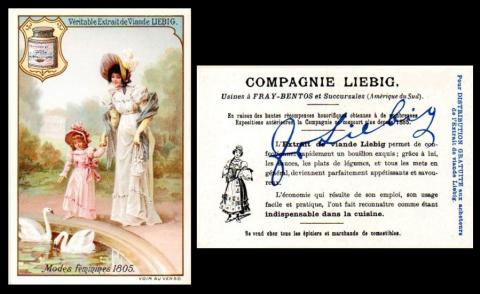
LIEBIG [trade : meat extract : O/S - South America] "Modes Feminines" (1905) F.0827 : S.0825
Today, on Fashion Day, let us remember that fashion is a fickle master, and, for the most part, no sooner have you saved up enough to buy an outfit it is already out of style. Though these days we are, thankfully, more conscious that buying all these outfits and discarding them is wasteful, of our money, but also of the materials, of the water, if the electricity, and of the man/woman, and often, shockingly, child power hours which were used to make them.
If you look up "Fashion" online, or in a printed dictionary, it often says words along the lines of it being a decorative item, often directly linked to a specific age. It also often says it is the way we try to enhance our appearance and make ourselves more attractive. It never seems to highlight the fact that, for the best part, the fashion which makes the headlines is that of rebellion and pushing boundaries.
The mother and child on this card are wearing identical clothing not just for fashion, but because at that time a child was not their own person. They were expected, even forced, to follow in their mother`s style - and footsteps, to be given a husband, and to have children; never to have a life of their own. In later times, a women who chose to go to college would wear rebellious "blue stockings", costume becoming ever more linked with acts of defiance, heading, ever onwards, to androgny, and Punk.
This set follows the fashions through the ages - 1760, 1780, 1805, 1830, 1860, and 1900.
The 1760s, especially in Europe, saw massive change to women`s clothing, seeing them become more informal in ten years than they had in the last forty, both for men and women. It is not by accident that a man appears on this card - and only one other does, on the card for 1830.
The 1780s are mostly notable for the fact that fashion reporting was spreading across Europe, at least in the larger towns and cities. Oddly, though, there were two definite trends for women, one following Marie Antoinette in her white muslin day dress, as shown on the card - and it is very interesting to see that the child also sports a white pompadour hairstyle. Whilst the other leant strongly towards masculinity. It is, when thinking along these lines, not surprising that the decade would end with the French Revolution.
By 1805, a compromise saw dresses with a thinner, more utilitarian shape, but often made of Marie Antoinette`s beloved muslin. It was a much more natural shape, and no longer forced beneath large structures that disguised the female form. Also you can see, for this is our card, that the child`s version is of a more pinkish hue.
1830 saw this all the more so, for a lot of the costumes were based on those from times past, and especially those which had been featured in a swathe of romantic novels using historical situations. Fashion definitely became brighter, aided by the rise of mechanical devices to render patterns on to dresses. Whilst the doll reminds us that at the start of this decade such an object was growing in popularity. In fact one of the first doll`s hospitals was opened, in Lisbon, Portugal. However it is also to this era that we owe the return of the corset, for it had been realised that some people were more shapely than others, something which could be overcome with more than a little pressure in the waist.
This led to the quite un-natural shapes of 1860, with a corset constricting the waist and an enormous hooped cage beneath a voluminous skirt making the hips appear monumental. easy cuts. Again technology helped with this, with the rise of artificial dyes, as well as the invention of sewing machines, which allowed clothes manufacturers to employ ladies simply to sew the dresses on demand. Another notable fashion fact from this decade saw the rise of The House of Worth, which had been opened by Jean Philippe Worth, in 1858, in Paris.
The very turn of the new century, 1900, saw not much change, or at least not until almost the end. The corset continued to constrict, though there was a subtle change to move the top forward and the bottom back without the former excessive iron pressure on the stomach being applied. The most important piece of this image, though, is the "Sailor Suit", which had first appeared after the Prince of Wales (later Edward VII) had worn a miniature version of a naval uniform aboard the Royal Yacht in 1846.
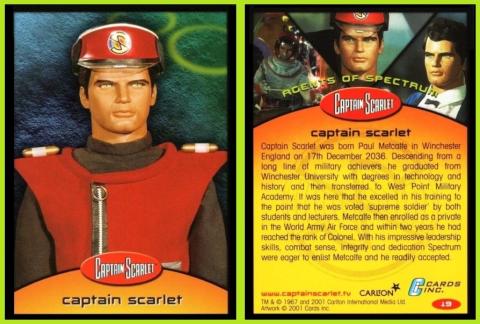
Cards Inc. [trade/commercial : cards : UK - Watford] "Captain Scarlet" (2001) 1/72
Today is Captain Scarlet Day, but, as this card tells us, it is not his birthday, that falls on the 17th of September, 2036. Yet the series, which features few actual day dates, uses this one date, the 10th of July, several times, as early as the second episode, which all takes place on that one day. It is also the date that the presumed dead body of the Mysteron Major Gravener is resuscitated. Later on we are told that Spectrum was founded on July 10th too. This may have gone on forever as a mixture of an in-joke and a mystery - but it was recently revealed that the date was the birthday of Tony Barwick, the writer of those, and many other episodes.
The series was titled "Captain Scarlet and the Mysterons", but often gets shortened to just the first two words, his name. It was a British series, and another from the marvellous minds of Gerry and Sylvia Anderson`s "Century 21" studio. Like the rest of their work, the show involves marionette puppetry and scale modelling. It was first shown on ITV in 1967, though only seems to have run for one year, or thirty-two episodes. Though it is often on television, somewhere in the world, to this day.
The action of Captain Scarlet began in the year 2068, after humans had gone to war with Mars over a misunderstanding, and the Martians proved to be armed, dangerous, and itching for a fight. There is more than a bit of a moral there.
Captain Scarlet was just an ordinary guy, until he acquired special powers, probably the most special of all, for he can heal from all injuries, even death. However, with this in mind, it was a rather dark series, hardly child friendly, and the war scenes frequently approached the boundaries of what was allowed on tv. On the other hand it did include a varied mix of people from all nations, (unusual for the time) joining together in harmony, in order to save the Earth and all its inhabitants.
As for original cards, the earliest issue is generally regarded to be Anglo Confectionery`s "Captain Scarlet and the Mysterons", a set of sixty-six cards issued in 1968. This was a mixture of stills from the television programme and art drawn scenes. That was followed, the following year, by Monty Gum`s set of the same name, which actually seems to be the same images. Can anyone confirm this?
Our set is later, and unusual because the base set was all that was issued in the packets. The other cards had to be purchased direct from the company - though several readers tell me that they did get sketch cards in with a packet or two. As for those "other cards", they are six embossed chase cards of the major characters, three oversized "box toppers", two autograph cards, nine preview cards, one promo card, and six "merchandise" cards.

D.C. THOMSON & Co. [trade : magazines : UK – London] “The World`s Biggest” (1937) Un/12 – THO-835 : ZB7-22
Now this day stumped me for a long while. I wanted to do World Population Day but could not find a card anywhere, and nobody else seemed to have one, and then a friend of a reader came up with this, which I had never seen before, though at first I did think he had cut it from a magazine, as it did not have an issuer and the back was a totally different subject. We had a good laugh about that though.
The front shows a line up of peoples in National Costume, and above their heads is the population of that place at that time. This called for a comparison list with today, especially now I have discovered how to make lists. However not all these dates are from this very day, but they are the most recent headcount for that area, and I was really fascinated by how they have changed.
| on card | today | |
| China | 420,000,000 - | 1,416,180,896 |
| India | 338,000,000 - | 1,467,230,000 |
| Africa | 150,000,000 - | 1,548,818,163 |
| United States | 137,000,000 - | 347,245,624 |
| Russia | 108,100,000 - | 146,028,325 |
| Japan | 84,000,000 - | 123,098,204 |
| S. America | 74,000,000 - | 438,091,467 |
| Germany | 66,000,000 - | 84,075,075 |
| Gt. Britain and Northern Ireland |
44,500,000 - | 67,596,281 |
Adding to my original conviction that this was not a set was the fact that it does not seem to appear amongst the Thomson listing in our original British Trade Index, but when you read the full header there is a list of anonymous "Z" codes, and one of them is actually this set, the entry for which reads :
- SET ZB7-22. THE WORLD`S BIGGEST (A). Lg. 82 m/m square. Back illustrated at Fig.ZB7-22. Unnd. (12). Issued with "Wizard" ... ZB7-22
caption on front heading on back 1. Big `Uns from Everywhere - - Highest Mountain Ranges 2. The Deep Sea Heavy Brigade - Which is the World`s Biggest Island? 3. Eleven Wonders of Bridge Building - The 29 Foremost Lakes in the World 4. Giants of the Wilds - Greatest Fires 5. Is Might Right in World Armies ? - Great Shortcuts for the World`s Shipping 6. Mammoths of the Railroads - Estimated Navies of the World in January 1936 7. Six Mammoths of the Seven Seas - Eighteen Super Railway Tunnels 8. Who`s First on the World`s Population Table ? - World`s Greatest Waterfalls 9. Wing Spans of the Air Kings - The Earth`s Mightiest Rivers 10. The World`s Tallest Races - Greatest Altitudes on World Railways 11. The World`s Tallest Storeys - The Merchant Fleets of the World 12. The World`s Wonder Warships - 30 Peaks on which the Snow never Melts
By the time of our updated British Trade Index, this set has been moved to within the Thomson listing, which makes life for the collector and researcher a lot easier. There, the set is entered as :
- THE WORLD`S BIGGEST (A) (W). 1937. 82 mm square. Unnd. 12. Anonymous. See HT-79. Album cover issued “Presented with Wizard” … THO-835
As for what HT-79 reveals, I will have to see if I get time for that later. If not it will be added over the weekend.
This week's Cards of the Day...
...once more saw us linking up with our sister hobby, philately, and joining Royal Mail to celebrate "the dazzling diversity of Britain's mushrooms".
And the stamps will be in your post office on the 3rd of July.
The stamps are the square format, and include both first and second class - the first class showing Amethyst Deceiver, Collared Earthstar, Fly Agaric, Penny Bun, and Turkey Tail - and the second class displaying Chicken of the Woods. Clustered Bonnet, Morel, Scarlet Elf Cup, and Scarlet Waxcap. .
Our celebration of clue cards started with :
Saturday, 28th June 2025
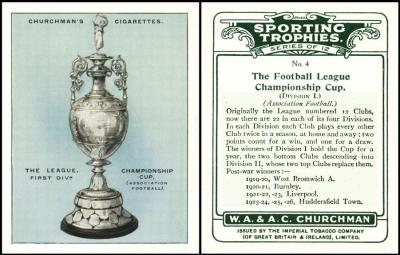
This clue was simply to a cup, which can be open cup, showing the gills if you turn the mushroom bottoms up, or closed cup, which are also known as "button" mushrooms. There are also many mushrooms which are proper cups, including the Scarlet Elf Cup, one of the second class stamps amidst this issue.
This sporting "cup" arose out of rather a confusing situation as to whether or not English football ought to be professional or amateur. The problem was that though the new Amateur Football Association hoped for the latter, many of the clubs that claimed to be amateur, would pay better players to come along and play from time to time in important matches. Then, in 1888, one of the directors of Aston Villa F.C. set about sorting this out. He wrote to several clubs, suggesting an annual competition which would set rules and guarantee that every club played against each other twice in a season, one match being at each of the club`s home grounds.
The first season saw twelve clubs compete, all from the northernly part of England, these being Accrington, Aston Villa, Blackburn Rovers, Bolton Wanderers, Burnley, Derby County, Everton, Notts County, Preston North End, Stoke, West Bromwich Albion and Wolverhampton Wanderers. The first winner was Preston North End, who successfully defended their title in the following year. The other two winners were Everton (in 1890) and Sunderland (in 1891). Now you are probably wondering where Sunderland came from, as they are not in the list above, and the answer is that for some reason In 1890, Stoke were not re-elected to the league. Instead, Sunderland were drafted in.
Then, in 1892, a second division was formed. But that is a different cup to ours.
This card tells us that the trophy is currently held by Huddersfield Town, for the 1926-26 season. The following season saw it go to Newcastle United, then to Everton, and then to The Wednesday, who are indeed Sheffield Wednesday but would not be called so until 1929.
Now as for when this trophy was replaced, that is a strange story. The original cup, which is not this one, was made in 1871 by Martin, Hall & Co., of Sheffield, for £20. In 1895, after it had been won by Aston Villa, the cup was being displayed in the window of a shoe shop in Birmingham when it was stolen. There was a reward offered, of £10, but the cup was never found, so the Football Association fined Aston Villa £25 in order to get a new cup made. Now eventually someone did come forward, in the 1950s, and claim to have stolen it and had it melted down - though there were several inaccuracies in their story and the claim was dismissed.
That cup was then re-made almost identical in 1895, presumably with Aston Villa`s money, and it was given between 1896 (to Sheffield Wednesday) and 1910 (to Newcastle United, who finally beat Barnsley after a replay).
Then it gets confusing as it says that in 1911, a new cup was designed, but in the design which is still used today, though the cup has been replaced several times - and it looks nothing like the one on our card either. So if anyone knows this cup we show today do let us know!
Anyway this set, along with its smaller sized sibling, which was our Card of the Day for August 5 2023, is first listed in our original Churchman reference book (RB.10), published in 1948, as :
- 131. April 1927. 25 SPORTING TROPHIES (titled series). Size 2 11/16" x 1 7/16" or 67 x 36 m/m. Numbered 1-25. Fronts printed by letterpress, 4-colour half tone process. Backs in dark green, with descriptions. Printed by Mardon, Son & Hall.
- 132. May 1927. 12 SPORTING TROPHIES. Similar format to (131) but size 3 5/16" x 2 9/20" or 80 x 62 m/m
Our original World Tobacco Issues Index shortens this to
- SPORTING TROPHIES. Nd. ... C82-80
A. Small (25)
B. Large (12)
And this text remains the same, though all on one line, in our updated version - though there is a new card code, of C504-655.
Sunday, 29th June 2025
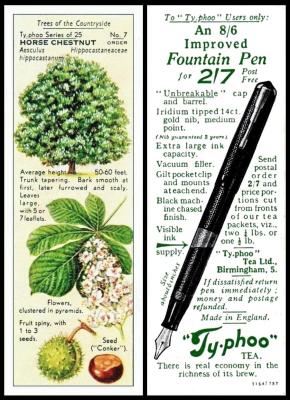
This card brings us "chestnut" - and chestnut mushrooms are the same as white mushrooms, apart from the colour, which has a brownish tinge. However they are getting more and more popular with growers as they do not need such a high temperature - and that not only saves on fuel bills but means that as our winters continue to get warmer they could extend our growing and consuming season. They are also more highly flavoured, and contain slightly more Vitamin D than other mushrooms, though all contain some.
Now if you look in our original British Trade Index under "Ty-Phoo Tea" you will be redirected, to "See Sumner`s Typhoo Tea". Once there, the entry begins :
SUMNER`S TYPHOO TEA
Cards issued about 1910-40, many bearing printer`s number and date indicating order of issue. Includes cards inscribed "Typhoo Tea" without Sumner`s name.
1. The "Long Cards" - size about 112 x 36 m/m.
- TREES OF THE COUNTRYSIDE. Back inscribed "1164/737". Nd. (25). Multi-backed, each with 2 or 3 advertisements. See C.C.N. Vol.16, page 8 ... SUM-18
As for the updated British Trade Index, that lists this set as :
TY-PHOO TEA, Birmingham.
Previously listed as "Sumner`s Ty-Phoo Tea". Issued 1910-1976. For convenience, all issues up to 1971 listed in this volume. Later issues in the post 1970 volume. Also on backs of cards issued by Spar Grocers.
- TREES OF THE COUNTRYSIDE. 1938. 102 x 36. Nd. (25). Multi-backed, each with 2 or 3 different wordings. See HT-127 ... TYP-640
As for the HT-127 reference, that directs us to the handbook to the updated British Trade Index. However then it gets a bit confusing as that entry is for Ty-Phoo`s "Important Industries of the British Empire", but what has been done is to use that as the listing for two other sets, which are similar - our set, and "Interesting Events in British History". So that is why this took a while to type in, as I had to figure our set out. So that newly worked out listing is :
- `Ty-phoo` Tea consists mainly of the delicate edges of the leaf - 3, 8, 18, 23.
- `TY-PHOO` TEA does not cause Indigestion - 4, 9, 14, 19, 24
- `TY-PHOO` TEA is grown upon the mountains of Ceylon - 3, 13, 18, 23
- `Ty-Phoo` Tea is highly recommended for the Nursing profession - 2, 12, 17, 22
- `Ty-Phoo` Tea is so different ! Note its mildness, its perfect blandness - 4, 9, 19, 24
- `Ty-Phoo` Tea is so pure, it cannot harm the weakest nerves -- 5, 15, 20, 25
- `Ty-Phoo` Tea is so rich in natural juices that it goes `just half as far again` - 4, 14, 19, 24
- `Ty-Phoo` Tea is the safe tea for invalids. Doctors recommend it ! - 1, 6, 11, 16, 21)
- `Ty-Phoo` Tea is the Tea that doctors recommend for weak digestions - 5, 10, 15, 25
- `Ty-Phoo` Tea may cost a little more, but it goes much further - 1, 6, 11, 16, 21
- `Ty-Phoo` Tea. One quality, THE BEST, and one price only - 2, 7, 12, 17, 22
- `Ty-Phoo` Tea saves you money and pleases you, too - 3, 8, 13, 18, 23
- `Ty-Phoo` Tea. There is real economy in the richness of its brew - 2, 7, 17, 22
Monday, 30th June 2025
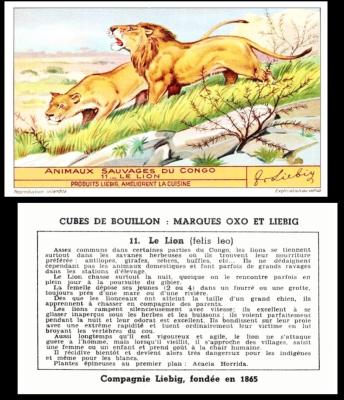
This clue could have just stood for `wild` mushrooms, as `Sauvages`, contrary to popular belief, does not mean savage, it just means wild.
However there is a mushroom called Hericium erinaceus, or lion's mane, and a very strange one it is too. It does grow in the British Isles but it is illegal to uproot or even take parts of it. The reason for this is that it has medicinal qualities, especially in Chinese medicine, where it is known as the yamabushitake.
This set seems to be sold as either a set of twelve, or two sets of six, numbers 1-6 and 7-12.
The cards in the set are :
- Le Crocodile
- L` Hippopotame
- Le Rhinoceros Noir
- L` Elephant D`Afrique
- Buffle Noir ou se Cafrerie
- Le Zebre Commun
- Le Grand Kudu
- L`Okapi
- La Girafe
- Le Leopard
- Le Lion
- Gorille du Kivu
Tuesday, 1st July 2025
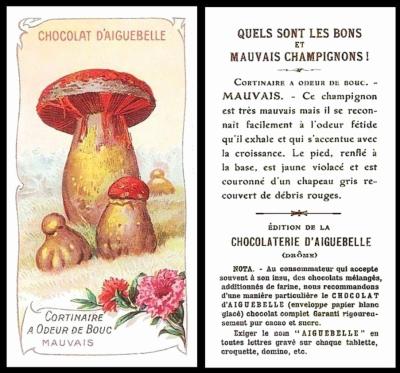
These mushrooms, despite the title, are not just labelled as good and bad, we also have an "Indigeste", a "Comestible", some "Tres Dangereux", a few "Veneneux" which means poisonous and even a "Tres Veneneux". And that is pretty much why we chose this one first, as not all mushrooms are edible, and more than that, the deadly and the tasty often look very much the same.
There seems that there would be few tackling this as a meal, for the name acts as a warning. It translates to goat-scented cortinaria, cortinarius being the parent category of fungi. In fact several mushroom hunting guides go further, calling it stinking, and one even reads "Odour : strong, frightening smell of goat". It is found between August and November on acid soil, most frequently beneath conifers and pines.
This is rather a confusing set, for some of the cards are upright, or vertical, like ours, and others are not only horizontal but, for the most part, have two different mushrooms on the front and include a note of where they grow. For a while I thought that there were two sets, one vertical and one horizontal, but the backs are identical on both sorts and the title, at the top of the reverse, is the same on every card. However, maybe I was right, for when they appear in our first ever Cartophilic Notes and News magazine, volume one number one, for January/February 1965, they are recorded as :
- Q1 - Quels sont les Bons et Mauvais Champignons ? (Which are the Good and the Bad Mushrooms?). Two series. Unnd
(1) Horizontal Format. 104 x 54. 16 known.
(2) Vertical Format. 106 x 55. 43 known
Now I have eighteen of the horizontal format, so that is just two extra - and if anyone would like to count the horizontals please do... though it may be easier (for someone else) to deduct the eighteen from the eighty one and arrive at the number of verticals that way. Anyway, here is a list
- Agaric Eleve-Coulumelle - Bon / Agaric Dartreux - Veneneux - (H)
- Amanite Ovoide - Bon - (V)
- Amanite Rougeatre - Bon - (V)
- Amanite Solitaire - Bon - (V)
- Armillaire de Miel - Mauvais - (V)
- Armillaire Bulbeuse - Bon - (V)
- Armillaire Robuste - Bon - (V)
- Bolet Blafard - Mauvais - (V)
- Bolet du Cepe - Comestible / Bolet Jaune - Mauvais - (H)
- Bolet Jaune Clair - Mauvais - (V)
- Bolet Rude - Comestible / Bolet Safran - Veneneux - (H)
- Bolet Tete de Negre - Bon / Bolet Pernicieux - Veneneux - (H)
- Champignon de Couche - Bon / Amanite Phalloide - Tres Dangereux - (H)
- Champignon des Pres de Rosee - Bon / Amanite Printaniere - Tres Dangereux - (H)
- Chanterelle Comestible Gyrole - Bon / Fausse Gyrole - Veneneux - (H)
- Clathre Grillage - Mauvais - (V)
- Clavaires - Bons - (H)
- Clitocybe des Bruyeres - Bon - (V)
- Clitocybe Nebuleux - Bon - (V)
- Clitocybe Vert - Bon - (V)
- Clitopile Orcelle - Bon - (V)
- Collybie a Pied en Fuseau - Indigeste - (V)
- Collybie de Chene - Bon - (V)
- Coprin Chevelu - Bon / Coprin Noir d`Encre - Veneneux / Coprin Noir et Blanc - ID - (H)
- Coprin Micace - Mauvais - (V)
- Cortinaire a Odeur de Bouc - Mauvais - (V)
- Cortinaire Eleve - Mauvais - (V)
- Cortinaire Violet - Bon - (V)
- Craterelle Corne d`Abondance - Bon - (V)
- Entolome Livide - Veneneux - (V)
- Fistuline Hepatique - Bon - (V)
- Helvelle Crepue - Bon / Helvelle Lacuneuse - Bon - (H)
- Hydnes - Bon - (H*)
- Hygrophore a Feuillets Jaunes - Mauvais - (V)
- Hygrophore Conique - Mauvais - (V)
- Hygrophore Jaune d`Or - Mauvais - (V)
- Hygrophore Rougissant - Bon - (V)
- Laccaria Vernisse - Bon - (V)
- Lactaire Orange - Bon / Lactaire aux Tranchees - Veneneux - (H)
- Lactair Pale - Bon - (V)
- Lactaire Poivre - Mauvais - (V)
- Lactaire Tache - Mauvais - (V)
- Lenzite Flasque - Mauvais - (V)
- Lepiote en Bouclier - Bon - (V)
- Lepiote Granuleuse - Bon - (V)
- Marasme faux-Mousseron - Bon / Hypholome Fascicule - Veneneux - (H)
- Morilles - Bon / Truffes - Bon - (H)
- Mousseron de St. Georges - Bon - (V)
- Mycene Incline - Mauvais - (V)
- Nyctalis a Spores Etoilees - Mauvais - (V)
- Oronge - Bon / Faux Orange - Tres Veneneux - (H)
- Paxille Enroule - Bon - (V)
- Paxille Veloute Noir - Bon - (V)
- Pezize en Coupe - Bon - (V)
- Pezize Veinee - Bon / Lycoperdon Vesse de Loup-Jeune - Mauvais - (H)
- Phalle Vulgaire - Veneneux - (V)
- Pholiote Ecailleux - Mauvais - (V)
- Pleurote du Chene - Bon - (V)
- Pleurote de l`Erygium - Bon - (V)
- Pleurote de l`Orme - Bon - (V)
- Pleurote de l`Olivier - Mauvais - (V)
- Pleurote en Coquille - Mauvais - (V)
- Polypore Chicoree - Bon - (V)
- Polypore des Brebis - Bon - (V)
- Polypore du Bouleau - Mauvais - (V)
- Pratelle Jaunissante - Bon / Amanite Citrine - Tres Veneneux - (H)
- Russule Cyanoxanthe (Charbonnier) - Bon / Russule Emetique - Veneneux - (H)
- Russule Doree - Bon - (V)
- Russule Gorge de Pigeon - Bon - (V)
- Russule Verdoyante - Bon - (V)
- Scleroderme Vulgaire - Mauvais - (V)
- Strophaire Vert de Gris - Mauvais - (V)
- Tricholome Ardent - Veneneux - (V)
- Tricholome Couleur de Soufre - Veneneux - (V)
- Tricholome Enfle - Mauvais - (V)
- Tricholome Equestre - Bon - (V)
- Tricholome Nu - Bon - (V)
- Tricholome Panache - Mauvais - (V)
- Tricholome Russule - Bon - (V)
- Vesse Loup Gigantesque - Mauvais - (V)
- Volvaire Gluante - Veneneux - (V)
So are there any others? If so do let us know.....
Wednesday, 2nd July 2025
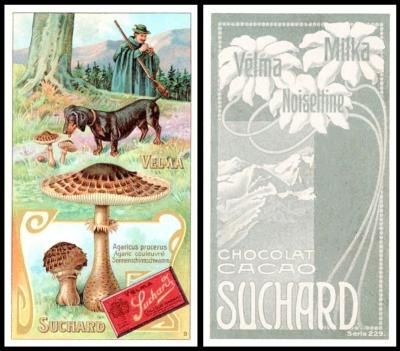
Another European mushroom today, included because of the dachshund, who is intent on smelling the fungi. At which anyone who had a dog will know it must smell pretty vile, and that any minute he will be sliding his face along it....
There is also a card in this set which shows a pig, smelling a truffle.
This is quite a rare set and it is very attractive. It is complete in twelve cards and they are numbered but they are in one of two different places and it is quite hard to see them, so we have a list, which also includes the brand of chocolate on the front of that card, and, in brackets, the location of the number :
- Morchella esculenta - Milka (bottom right)
- Cantharellus cibarius - Milka (bottom right)
- Boletus scaber - Milka (bottom left)
- Clavaria lava - Noisettine (bottom left)
- Hydnum rependum - Noisettine (bottom right)
- Agaricus procerus - Velma (bottom right)
- Lactarius deliciosus - Noisettine (bottom right) ?
- Tuber melanospore - Milka (bottom left)
We know that "Velma" was made about 1900, but "Milka" was not made until 1901. However we do not have a firm date for the issue of this set. It appears that there are four cards for each brand, and all the "Milka" ones are known, but there are currently only one "Velma" and three "Noisettine" - and four missing cards which would make it into a complete set.
Thursday, 3rd July 2025
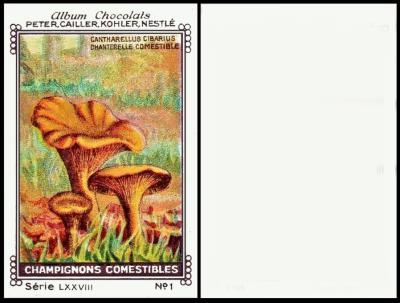
this set follows a similar bad/good theme, but splits the edible and inedible mushrooms into two separate sets.
Champignons Comestible
- Cantharellus Cibarius - Chanterelle Comestible
- Boletus Aereus - Bolet Bronze
- Morchella Esculenta - Morille Comestible
- Morchella Conica - Morille Conique
- Hydnum Repandum - Hydne Sinue Stoffelschwann
- Lactarius Deliciosus - Lactaire Delicieux Kostling
- Lycoperdon Gemmatum - Vesse Loup
- Boletus Badius - Bolet Fauve
- Boletus Equlis - Bolet Comestible
- Amanita Calcarea - Oronge Vraie Kaiserling
- Lepiota Procera - Lepiote Elevee Parasolpter
Champignons Veneneux
- Russula Rubra - Russule Rouge
- Mycena Epipterygia - Mycene des Fougeres
- Tricholoma Sulfureum - Tricholoma Soufre
- Russula Ochroleuca - Russule Jaunatre
- Amanita Phalloides - Amanite Phalloide
- Amanita Pantherina - Amanite Panthere
- Amanita Verna - Amanite Printaniere
- Lactaire Torminosus - Lactaire des Tranchees
- Amanita Citrina - Amanite Citrine
- Russula Emetica - Russule Emetique
- Volvaria Speciosa - Volvaire Remarquable
- Amanita Muscaria - Fausse Orange
Of course that would be too easy, given the chequered story of Nestle and its mergers, so these two sets are found with more than one set number and also more than one front design.
The ones we know of so far are :
Champignons Comestibles
- Serie VIII - (8) - "Nestle`s Chocolats au Lait" in bottom panel - "Champignons Comestibles" above top frameline
- Serie XIX - (19) - "Champignons Comestibles" in bottom panel - "Peter Kailler Kohler" above top frameline
- Serie LXXVIII - (78) - "Champignons Comestibles" in bottom panel - "Nestle Peter Kailler Kohler" above top frameline
- Serie 78 - "Champignons Comestibles" in bottom panel - "Nestle Peter Kailler Kohler" above top frameline
Champignons Veneneux
- Serie IX -(9) - "Nestle`s Chocolats au Lait" in bottom panel - "Champignons Veneneux" above top frameline
- Serie XX - (20) - "Champignons Veneneux" in bottom panel - "Peter Kailler Kohler" above top frameline
- Serie LXXIX - (79) - "Champignons Veneneux" in bottom panel - "Nestle Peter Kailler Kohler" above top frameline
- Serie 79 - "Champignons Veneneux" in bottom panel - "Nestle Peter Kailler Kohler" above top frameline
Friday, 4th July 2025
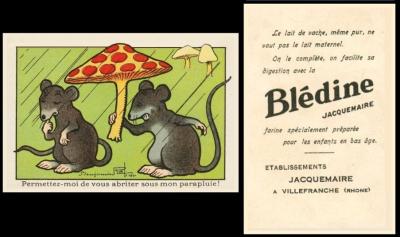
So our final card comes with a little tale. For our mushroom cards have been supplied this week by a reader, who is quite a well known botanist, specialising in mushrooms.
A long while ago he was sent a card of a mushroom by a friend, (it was actually Wills "Do You Know" first series, card 46, about how to tell a mushroom from a toadstool), and he was amazed, he had never come across cards before. Sadly there are not too many cigarette cards of mushrooms and toadstools, but then he discovered all the European chromos and trade cards, which are a bit more plentiful.
Anyway one day he was sent today`s card by the same friend, and being into factual cards not frivolous ones he put it in a drawer and forgot about it. Then he hit a bit of a bad patch, during which he came across this little pair of mice again and it was the first thing in a long time which had made him smile. So he started hunting out humorous cards of mushrooms and toadstools, ones with frogs and elves on them, or sheltering beneath, and even a few with people turned into mushrooms. And now he tells me that he actually prefers these to his original collection, with all the serious cards.
Sadly this is the only card he has in this set, and he does not even know what the rest of the cards could show.
I had a look and could not find any Bledine or Jacquemaire like this one, so I can only give it the guessed title of "Animaux Comique", or comical animals .
The title on the card translates to "allow me to shelter you underneath my umbrella" and there is a signature, of the artist, but I cannot fathom it out, and it is getting late. I will have another look, with two pairs of glasses, tomorrow.
So there we go, your newsletter is put to bed and I shall follow.
"Putting to Bed" is a printing term, and it means checking through the edition and making sure there are no errors, whether that be spelling, or the columns not quite lining up. However there is another connection, for in the olden days you would take your letters, one at a time, which were small blocks, and tap each one firmly in next to the letter before, making sure that they lined up. To do this you needed a flat surface with a lot of grip, and that was called a "print bed". So technically "Putting to Bed" means making sure all the letters are lined up to the same height and depth, and that each line ends square to the line above and below. If one letter was not high enough, it would not print, or only print partially, because the ink would not go on that letter, or if one letter was too high it would blur, because it would get too much ink inside its form.
That`s your printing lesson for tonight. But it does explain why some cards have letters or sections of words missing. And next time you see this on a card you will suddenly know the reason why.....
See you next week!
